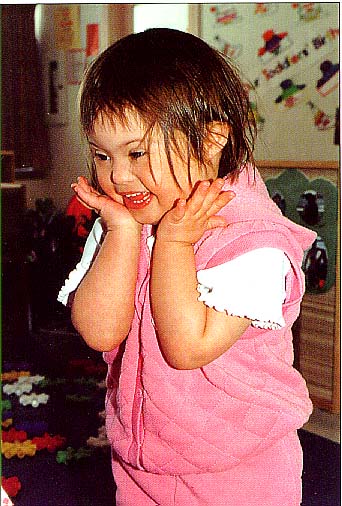

Let's Pretend...The Importance of Dramatic Play
by Bonnie Sturm
 "I'm the mommy, you be the baby...I'm a roaring tiger, a choo choo train... I'm the police, listen
to me... Let's pretend that..."
"I'm the mommy, you be the baby...I'm a roaring tiger, a choo choo train... I'm the police, listen
to me... Let's pretend that..."
All of these fantasies are real in the minds of children who are engaged in dramatic play. Children can switch roles -- from animate to inanimate objects -- with a blink of an eye. To many of us, this is what childhood is all about: the ability to be anything we want without a worry in the world. Carefree, creative dramatic play promotes cognitive development and helps children learn how to share, communicate and cooperate with each other. Through role playing children also learn how to develop empathy for others.
As caregivers, our role is to enrich the dramatic play of children in our care. This can be accomplished by providing non-intrusive supervision of children's free play. While one child may welcome suggestions and comments, another may reject any adult intervention. Be careful not to allow dramatic play to become a "teaching" situation as it will alter the value of the play for the children. The goal is to stimulate play not dominate it.
There are many ways to enhance children's dramatic play. Field trips can encourage the development of new roles and situations in make-believe dramas. For example, the activities observed during a trip to the hospital can expand a child's idea of "doctor" play. Props can also be introduced to stimulate children's imaginations. Here are some simple, inexpensive items that can be incorporated into the play areas of any child care centre:
Water
Water is a great addition to any play area. Try a squirt bottle in the hair dressing centre, some dish soap and towels in the housekeeping area, cups and a teapot full of water in the day care restaurant, and a basin and wash cloth in the baby centre. A squirt bottle, for example, can help children develop small muscle strength and eye-hand coordination. Empathy and an understanding of personal hygiene are enhanced when children are able to bathe their dolls. Pouring and measuring water give children a basic understanding of science and math. For example, comparing a dish full of water with one that is empty helps children understand the concept of weight. Pouring a cup of tea helps children estimate quantity as they discover how much water the cup can hold.
Boxes
Boxes of all sizes are another budget-wise addition to any play area. A box can become anything a child's imagination makes it. Allowing children to use art materials to produce a make-believe world enhances their planning and problem solving skills as well as their creativity.
Boxes may also be used to enhance a theme-based dramatic play centre. For example, a box can be used to make a cage for a stuffed animal pet store by cutting a small door on one side and a barred window on the other side. A box may also be fashioned into a "ride-em" toy by closing the flaps, cutting out the bottom and making a hole in the top that is large enough for a child to climb through. Then, attach strings to make shoulder straps and use paint or other pieces of cardboard to give the box animal-like characteristics.
Boxes are also wonderful tools for creativity when they are flattened. Take two large, flattened boxes and cut out the shape of a pirate ship on each one. Then, mount the cardboard ships to the sides of the stove or sink in your housekeeping area. Just add a wrapping paper roll for the mast and a sheet for the sail and your buccaneers will be ready for a voyage.
As caregivers, we can also be creative with the materials we have available. For example, a housekeeping area can be transformed into a car or train by using everyday materials. Just cover the top of a sink or stove with a sheet of construction paper, tape down a row of pill bottle lids and you have your instrument panel. To encourage early word recognition, use pictures and words to describe the functions of each key. For example, a picture of a lightbulb can indicate headlights and a trumpet shape can represent a car horn. To create a steering wheel, tape a wrapping paper tube to the car and cover the end with an ice cream lid (using a split pin to secure it). Add a chair and the children will be ready to travel wherever their imaginations takes them. The car can be modified to form a train by adding more chairs and a smoke stack made out of a wrapping paper tube.
Books
Books, borrowed from your local public library, can also provide children with inspiration for their
dramatic play as they recreate and alter stories they have heard or read.
Of course, the most economical aspect of any dramatic play centre is you! Go ahead and create
centres for the children to learn and explore. It need not be extravagant, expensive, or perfect.
Although simplistic, "small" things really CAN amuse "small" minds.
Written by Bonnie Sturm, a child care professional in Medicine Hat, Alberta
Photo credit for both photos: City of Medecine Hat Children's Services
|
This article first appeared in Interaction published by the Canadian Child Care Federation, Fall, 1994. |

|
|
 |  |  |